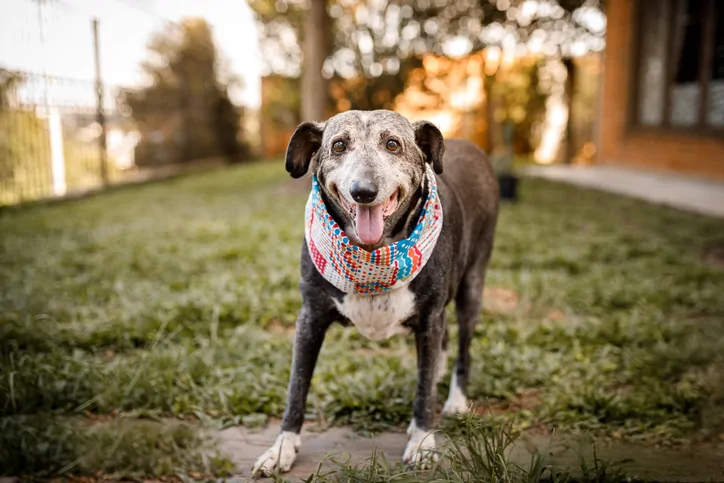For many pet guardians, their four-legged companions are their most loyal and loving friends. It's a bittersweet connection, knowing that, chances are, you will outlive your beloved pet, and be faced with that grief. Consequently, many animal lovers observe the signs of aging in their pets with trepidation. However, pets age in stages, and, like with the aging humans in our lives, their golden years are an opportunity for us to treasure our time with them and show our gratitude for the love and laughter they bring to our lives.

Small dogs and cats are typically categorized as "seniors" at seven years old. In comparison to smaller breeds, larger breed dogs tend to live shorter lives and are frequently regarded as “seniors” around the age of 5 to 6 years old. Pets are surviving longer than ever thanks to advances in veterinarian treatment and dietary practices but may still experience age-related issues. Nevertheless, with the right care, your furry family member can age happily, healthily, and actively.
Dogs and cats experience many of the same age-related health issues but the signs of illness can manifest in different ways. Signs of aging in dogs include:
Cats show more subtle signs of aging than dogs, so you may have to be especially observant with your elderly cat. The signs of aging in cats include:
Noticing signs of aging in your pet does not mean it's time to panic, it simply means your pet may need extra care and attention going forward. Subtle changes to your pet's routine, vet care, and changes to their environment can help them stay healthy longer.
No matter what species your pet may be, all elderly pets benefit from semi-annual veterinary visits, geriatric diets, low-impact exercise, and changes to their environments. Semi-annual veterinary visits make it possible for vets to detect signs of illness quickly for more effective treatment and better outcomes. Doing senior blood work every 6 months to a year for early detection is key.
Parasite control and dental care are also vital to the health of older pets. Your vet will perform more in-depth examinations as your pet ages and may do periodic lab work to check your pet's liver and kidney function.
Geriatric pet diets consist of easily digestible ingredients with calorie levels that are more appropriate for aging pets and include anti-aging nutrients. Your vet can recommend the best formula of high-quality pet food for your pet's specific needs.
Low-impact exercise helps keep aging pets active, eases joint pain, and improves mobility. For pets who suffer from arthritis, specialized diets, joint supplements, and anti-inflammatory medicines formulated for pets may ease your pet's symptoms and help them feel like being more active. Alternative therapies for pet arthritis include acupuncture, electron conversion therapy, chiropractic care, and stem cell therapy. In extreme cases, your vet may use a surgical approach by removing damaged tissue or replacing worn joints.
Assistive changes to your pet's environment can help them maintain their daily routines. Providing soft, non-slip surfaces for pets to walk on and ramps for climbing into cars or onto couches help many pets with mobility issues. Keeping your pet warm and supplying them with comfortable bedding soothes joint pain.
Some of your pet's care needs may be species-specific. For instance, dogs need more exercise and activity to stay mobile than cats do. Elderly cats who aren't feeding well benefit from having water and food bowls in several places around the house so they don't have to go far to feed, whereas, dogs are better served by providing elevated food bowls. Dogs benefit from the use of support slings for assistance with walking and climbing into the car but such devices are of little use to cats.
If your pet has a serious condition and there is no hope of recovery, pet hospice care, referred to as palliative care, is an option. The idea is to utilize the right combination of painkillers, nutritional modifications, and human interaction to make your pet's final days or weeks more bearable. Pet hospice is not a physical location, but rather a philosophical and personal decision based on the idea that dying with dignity is both possible and a natural part of life. Pet owners should be cautious not to prolong the suffering of animals who are in pain or have a poor quality of life when considering hospice care.
If your pet is suffering, the most compassionate option may be euthanasia. Euthanasia can end your beloved pet's suffering without pain. Veterinarians receive specialized training to provide your pet with a dignified and humane end. The process involves an injection of a sedative, followed by an injection of a specific drug. The treatment, which lasts between 10 and 20 seconds, is comparable to receiving general anesthesia during surgery and causes the animal to have no awareness of what is happening.
Following the loss of a cherished pet, it's common to experience a range of difficult emotions. No matter what you are feeling, remember that there is no right way to mourn. Try to remember the good times and build a support system that includes people who loved your pet as much as you. if the intensity and duration of your grief become overwhelming, it is best to talk to your doctor or a mental health professional to develop a treatment plan that can help you feel better moving forward.
Phone: (855) 461-8259
Email: [email protected]